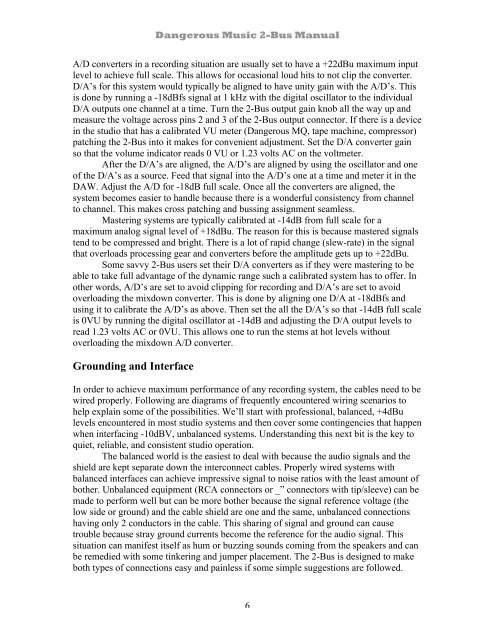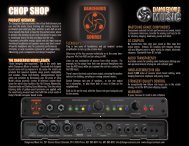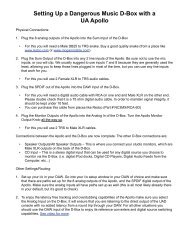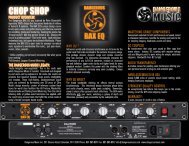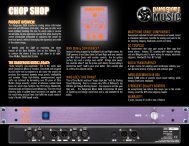The Dangerous Music 2-Bus Manual
The Dangerous Music 2-Bus Manual
The Dangerous Music 2-Bus Manual
You also want an ePaper? Increase the reach of your titles
YUMPU automatically turns print PDFs into web optimized ePapers that Google loves.
<strong>Dangerous</strong> <strong>Music</strong> 2-<strong>Bus</strong> <strong>Manual</strong><br />
A/D converters in a recording situation are usually set to have a +22dBu maximum input<br />
level to achieve full scale. This allows for occasional loud hits to not clip the converter.<br />
D/A’s for this system would typically be aligned to have unity gain with the A/D’s. This<br />
is done by running a -18dBfs signal at 1 kHz with the digital oscillator to the individual<br />
D/A outputs one channel at a time. Turn the 2-<strong>Bus</strong> output gain knob all the way up and<br />
measure the voltage across pins 2 and 3 of the 2-<strong>Bus</strong> output connector. If there is a device<br />
in the studio that has a calibrated VU meter (<strong>Dangerous</strong> MQ, tape machine, compressor)<br />
patching the 2-<strong>Bus</strong> into it makes for convenient adjustment. Set the D/A converter gain<br />
so that the volume indicator reads 0 VU or 1.23 volts AC on the voltmeter.<br />
After the D/A’s are aligned, the A/D’s are aligned by using the oscillator and one<br />
of the D/A’s as a source. Feed that signal into the A/D’s one at a time and meter it in the<br />
DAW. Adjust the A/D for -18dB full scale. Once all the converters are aligned, the<br />
system becomes easier to handle because there is a wonderful consistency from channel<br />
to channel. This makes cross patching and bussing assignment seamless.<br />
Mastering systems are typically calibrated at -14dB from full scale for a<br />
maximum analog signal level of +18dBu. <strong>The</strong> reason for this is because mastered signals<br />
tend to be compressed and bright. <strong>The</strong>re is a lot of rapid change (slew-rate) in the signal<br />
that overloads processing gear and converters before the amplitude gets up to +22dBu.<br />
Some savvy 2-<strong>Bus</strong> users set their D/A converters as if they were mastering to be<br />
able to take full advantage of the dynamic range such a calibrated system has to offer. In<br />
other words, A/D’s are set to avoid clipping for recording and D/A’s are set to avoid<br />
overloading the mixdown converter. This is done by aligning one D/A at -18dBfs and<br />
using it to calibrate the A/D’s as above. <strong>The</strong>n set the all the D/A’s so that -14dB full scale<br />
is 0VU by running the digital oscillator at -14dB and adjusting the D/A output levels to<br />
read 1.23 volts AC or 0VU. This allows one to run the stems at hot levels without<br />
overloading the mixdown A/D converter.<br />
Grounding and Interface<br />
In order to achieve maximum performance of any recording system, the cables need to be<br />
wired properly. Following are diagrams of frequently encountered wiring scenarios to<br />
help explain some of the possibilities. We’ll start with professional, balanced, +4dBu<br />
levels encountered in most studio systems and then cover some contingencies that happen<br />
when interfacing -10dBV, unbalanced systems. Understanding this next bit is the key to<br />
quiet, reliable, and consistent studio operation.<br />
<strong>The</strong> balanced world is the easiest to deal with because the audio signals and the<br />
shield are kept separate down the interconnect cables. Properly wired systems with<br />
balanced interfaces can achieve impressive signal to noise ratios with the least amount of<br />
bother. Unbalanced equipment (RCA connectors or _” connectors with tip/sleeve) can be<br />
made to perform well but can be more bother because the signal reference voltage (the<br />
low side or ground) and the cable shield are one and the same, unbalanced connections<br />
having only 2 conductors in the cable. This sharing of signal and ground can cause<br />
trouble because stray ground currents become the reference for the audio signal. This<br />
situation can manifest itself as hum or buzzing sounds coming from the speakers and can<br />
be remedied with some tinkering and jumper placement. <strong>The</strong> 2-<strong>Bus</strong> is designed to make<br />
both types of connections easy and painless if some simple suggestions are followed.<br />
6


